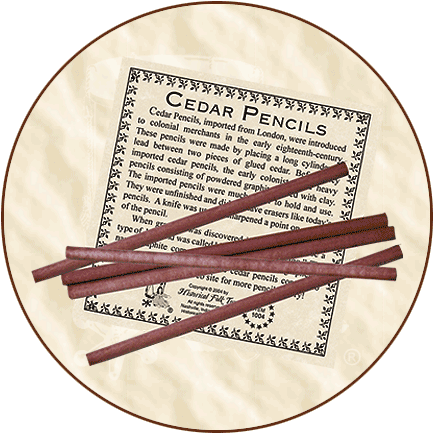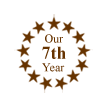.
Continued from product description
on Early Education's Page
Two...
Historical
Background: The word "pencil" comes from the
Middle English word "pensel" and the Middle French
word "pincel," which is derived from the Latin word
"penicullus" (meaning a painter's brush, pencil or
stylus). The English word "pencil" came into use in
the late-16th century to describe what we call it today.
The first pencils were produced in Keswick, England, with
Cumberland Graphite. Pencil making was first a cottage industry
in Keswick with families making artists' pencils in their homes.
These home-based pencil "factories" were the origin
of the pencil industry.
Graphite was discovered in 1500 in Cumberland, Keswick, England,
when shepherds went to check on their sheep after a violent storm.
They found a black material under the subsoil that had been torn
away where trees fell. They first thought this black material
was coal, but it would not burn. It proved to be an excellent
means for marking their sheep, though. The British government
took over these mines after it discovered how valuable this black
material was. This material was first called "Wad"
and a graphite pencil was known locally there as a "Wad
pencil." The mines in Keswick produced graphite for over
300 years until they closed in 1890.
Graphite was called black lead or "plumbago" because,
at the time it was discovered, it was thought to be a type of
lead. The name graphite comes from the Greek word "graphein,"
which means "to write."
Around 1560, graphite wrapped in string or inserted in wooden
tubes came into use as writing utensils. It is the carbon found
in graphite that gives it its degree of blackness. Pencils were
produced in Nuremberg (now Germany) in 1662 but were inferior
to pencils made in England. The process of mixing graphite with
clay and water was invented by French chemist and Napoleon courier
Nicolas-Jacques Conte in 1795. This became the best process for
making pencil leads and is still used today.
In 1812, William Munroe produced wood-cased lead pencils in
Boston, Massachusetts. He and other pencil makers began manufacturing
pencils with dried graphite paste, which was inferior to the
English-made pencils made from higher quality graphite.
"Pencils made with high-quality Asian graphite were painted
yellow to indicate the source of the graphite." Most of
the pencils manufactured today are still painted yellow. The
pencil industry grew as demand increased. Over 20 million pencils
were being consumed in the United States during the early 1870s.
In 1892, Dixon Crucible manufactured more than 30 million pencils.
By 1912, U.S. production of pencils was 750 million and the world's
production was 2 billion.
Benjamin Ball made square leads for pencils in the mid-19th
century. They were typically off-center and the wood cases were
somewhat out-of-round. Square lead was commonly used in most
wood-cased pencils until the mid-1870s. All black lead pencils
exhibited at the Centennial in Philadelphia in 1876 contained
square leads. Square leads were the norm for a long time because
they were easier and faster to make. A square grove was cut into
the wood of the pencil casing and then lead was inserted and
trimmed. Another piece of wood casing was then put on top and
glued. Square lead pencils were produced until the last quarter
of the 19th century.
Different machinery was needed to produce the casings for
round lead wood pencils. When dealing with round leads, a rounded
grove would have to be cut into both top and bottom pieces of
the casing. Round pencils were not always perfectly centered.
"Joseph Dixon Crucible Company was among the first manufacturers
of pencils to use round leads," which happened after the
Centennial. When pencil sharpeners were invented, pencil manufacturers
had to center the leads in the casing or the sharpened pencil
point would be off-centered. (If you would like to see how a
cedar pencil is made, visit Musgrave Pencil Co. Inc. online at
www.pencils.net/slats.cfm.)
Eventually, pencils were numbered 1 to 4 to indicate the hardness
of the lead, with 4 being the hardest lead. Later, letters were
used to describe pencil leads:
H -- hard;
B -- blackness of the pencil's mark;
F -- indicates that a pencil can be sharpened to a very fine
point;
HB -- hard and black; and,
HH -- very hard.
Besides graphite pencils, there were also slate pencils. School
children used slate pencils during the second half of the 19th
century and the early part of the 20th century to write on tablets
cut from harder grades of slate. Slate pencils are narrow slips
cut from solid pieces of softer grades of slate or soapstone
and do not contain graphite. Slate pencils were available with
the slate core unwrapped, wrapped in paper, or encased in wood
like a lead pencil. Until the 1930s, Eagle Pencil Company sold
wood-cased slate pencils with fiber erasers. Other companies
that advertised slate pencils were Holden & Cutter (Boston,
Massachusetts circa 1840-1860); Grigg & Elliot (Philadelphia,
Pennsylvania circa 1850-1860); and Charles J. Cohen (Philadelphia,
Pennsylvania circa 1878).
Fun
Fact: "Bullet Pencils" were also called pencil
holders, which got their name from a rifle cartridge. Civil War
soldiers stored their pencils in the end of a used rifle cartridge
so that the pencil tips would not break off in their packs.
Fun
Fact: Two billion pencils are made in the U.S. each year.
If laid end to end, a year's production of U.S. pencils would
go around the world's equator about 15 times!
Fun
Fact: Erasers were attached to pencils with a "ferrule"
in 1858.
Fun
Fact: A pencil lead or a line drawn by a pencil will conduct
electricity!
Fun
Fact: Colored pencils are made from chalk, clay or wax
and mixed with binders and pigments.
Fun
Fact: One pencil will draw a line 70 miles long!
Fun
Fact: The average pencil can be sharpened 17 times.
Fun
Fact: Francis Scott Key wrote "The Star Spangled
Banner" in pencil.
Fun
Fact: A good-size tree will make about 300,000 pencils.
Fun
Fact: Most of the graphite used for today's pencils comes
from Sri Lanka, Madagascar, Mexico, and Siberia.
Early
Pencil Manufacturers: William Munroe (Boston area, 1812),
Benjamin Ball (Harvard, Massachusetts, 1820s-1850s), John Thoreau
(father of Henry David Thoreau), and Joseph Dixon.
Companies
That Advertised Other Manufactured Pencils: Holden &
Cutter (Boston, Massachusetts) advertised French and English
lead pencils circa 1840-1860; Grigg & Elliot (Philadelphia,
Pennsylvania) advertised Faber's, Guttknecht, and Brookman &
Lagdon's lead pencils circa 1858.
Other
Pencil manufacturers: Musgrave Pencil Company (since 1916),
Dixon Ticonderoga Company, Cumberland Pencil Company (www.pencils.net.co.uk),
Atlas Pen & Pencil, Eagle Pencil Company (in 1862, they won
an award in London); Eberhard Faber (their factory in New York
made pencils using leads from Germany); The American Lead Pencil
Company; and Joseph Dixon Crucible Company. The last three companies
were the principle U.S. manufacturers of pencils in latter 19th
and early 20th centuries.













